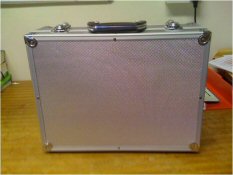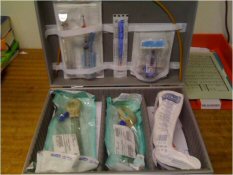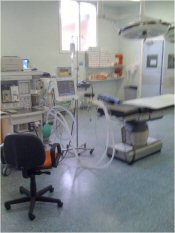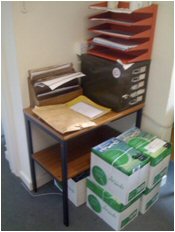MPH Anaesthesia
Trainees
About
Home
To Do Soon
-
-
There is a meeting that you have to attend. There are also many systems for which you need to get usernames and passwords:
- 1. Trust induction
-
- Hopefully during this meeting much of what follows can be "ticked off".
- 2. Trust's Intranet
-
Username and password.
- Allows you to log into the Trust's computer system.
- It is important that you put on the form somewhere that you want access to the "Anaesthetic Common Drive", because they keep on forgetting to do this.
- No patient-identifiable data should be saved onto the hard drive of the computer you are using - it should all be saved onto your personal network drive (which will be assigned, as well as, hopefully, the common drive)
- The Common Drive can be accessed by other anaesthetists, so is useful if you want to share a file. Beware that it is accessible (with a bit of work) by anyone who logs on, not just anaesthetists. You have your own personal drive which nobody else should be able to access.
- 3. OrderComms
-
Username and password.
- Allows you to order investigations (including X-Rays) and view test results.
- 4. PACS
-
Username and password.
- Allows you to view X-Rays.
- 6. Swipe Card
-
- Allows you access to General, Orthopaedic and Head & Neck Theatres (and the latter two's changing rooms). This may be given at the Trust's induction, but Sam Harris in Main Theatres (i.e. not our secretary Sam) can provide them.
- 7. Anaesthetic key code
-
- Get this from the anaesthetic secretaries, or just ask an anesthetist and marvel at their non-verbal communication.
- 8. Codes for various doors
-
- As well as the anaesthetic office, there are places that do not use swipe cards, but key-pads, e.g. Main Theatres & Day Surgery changing rooms and maternity Wards. There is a code for the Paediatric wards, but they tend to be very protective over it - it is normally easier just to buzz and say you are the anaesthetist.
- 9. Departmental Rota
-
Username and password.
- Our rota is online at www.mphar.com Contact Boris Donovan and he will provide you with a username and password. There is a free app for the iPhone - FAQ: server is musgrove.clwrota.com/app
- 10. Anaesthetic intranet website
-
Username and password.
- A repository for past lectures, recipes for operations, contact, etc. You do not need a password, but it does give a few extra goodies like contact numbers. Contact me, Ian Sidwell, and I will provide you with these.
- 11. Electronic Trauma Board
-
Username and password.
- Trauma Lists are electronic and can be accessed on the intranet. Contact the Trauma Coordinator, and she will provide you with these.
- 12. Parking
-
- Fill in a QPark form and take it to their office (outside the Duchess Building) with your driver's license and bank details. If you live nearby, you may need to reiterate you do on-call.
- 13. Department Calendar (to expand)
-
- You can access the department calendar using a computer, iPhone, etc. Instructions are at http://195.105.0.110/tst/Anaesthesia/Calendar Instructions.html
- 14. Level 2 Child Protection
-
- This is done online on the intranet - at http://mollie.tst.nhs.uk. Instructions for access can be found at http://195.105.0.110/tst/Anaesthesia/Mollie Guide - Child Protection Level 2.pdf. This is only available when connected to the intranet.
-
The Department
-
-
The Anaesthetic Department is situated in the old building. The main door from the corrider after hours and the bck entrance from theatre are accessed with your normal swipe card.
- The Secretaries Office
-
- The Department is run by Joanne and Sam, who produce the weekly rota (with help from Boris Donovan), answer questions and generally know what's going on.
- In the secretaries' office are also leave forms.
- The Anaesthetic Director's Office
-
- There is a door to a room next to the secretaries' office, which is where the Boss lives.
- The (rest of the) Consultants' Office
-
- The big room is where the rest of the Consultants live, and is also the room where meetings and tutorials are held.
- Leave that has been approved is posted on a wall (next to the xray box) in this room.
- Trainees' Room
-
- There is also a trainees' room, which is through a door to the right (then first door on the right again) as you come into the department from the corridor. It requires code that is provided by Joanne and Sam.
-
Who's Who
-
-
The Boss
- Dave Creasey.
The Trainee's Boss (College Tutor)
- Mitesh Khakhar - his office is to the left after you enter via the double doors from the corridor.
ITU Tutor
- Richard Gibbs - desk in the corner opposite the entrance of the Consultant's room.
- Specialists
-
Bariatrics
- Dr Nick Kennedy - Clinical Lead.
- Dr Mohamed Lone.
Day Surgery
- Dr Helen Hopwood - Clinical Lead, also Maternity.
ITU
- Dr Richard Gibbs - ITU Tutor.
- Dr Richard Innes - ITU Lead.
- Dr Nick Kennedy - also Bariatric Specialist.
- Dr Heléne Lindsay.
- Dr James Sidney.
- Dr Joe Silsby - also Safer Patient Initiative (SPI).
Maternity
- Dr Julie Lewis - Clinical Lead.
- Dr Jane Bellamy - also POAC lead.
- Dr John Clear.
- Dr Helen Hopwood - also Day Surgery Lead.
- Dr Heléne Lindsay. - also ITU.
- Dr Jane Thurlow - also College Tutor.
Ophthalmology
Orthopaedics
- Dr Dave Creasey - Clinical Lead, also 'The Boss'.
Paediatrics
- Dr Rachel Brown - Clinical Lead.
- Dr Dave Creasey - also Leave Coordinator and Vascular.
- Dr Mitesh Khakhar - College Tutor.
- Dr Mike Walburn.
Pain
- Dr Suzanne Carty.
- Dr Barry Nicholls - Acute. Also Regional Anaesthesia Lead.
Regional
- Dr Barry Nicholls.
- Dr Boris Donovan - also IT Lead, Rotamaker and Leave Coordinator.
Vascular
- Dr Dave Creasey - also Orthopaedic Lead.
- Dr Mitesh Khakhar - also College Tutor.
- Dr Justin Phillips.
- Dr Joe Silsby - also Audit Coordinator and SPI.
All Rounders
- Dr Suzanne Carty - also gynaecology enhanced recovery.
- Dr Stu Collins - College assessor.
- Dr Ian Gauntlett - Directorate Lead.
- Dr Geer Hubregtse.
- Dr Tim Zilkha - also a hospital governor.
Difficult Airway
- Dr Simon Marshall - Clinical Lead.
Information Technology
- Dr Boris Donovan - Clinical Lead, also Regional Anaesthesia, Rotamaker and Leave Coordinator
- Dr Ian Sidwell. - webmaster.
Associate Specialists
- Dr Eleanor Zaremba.
- Dr Andreas Kraemer - Twilight & Weekend Trauma Rotamaker.
- Dr Mohammed Lone - bariatrics.
- Dr Emma Pascall.
- Dr Jackie Pullin.
- Dr Ian Sidwell - webmaster.
Staff Grades
- Dr Michelle Pearce.
-
Theatres
-
- Main Theatres
-
Theatre 1
- This is a dedicated Emergency Theatre.
- The theatre list is on the white board outside theatre 1.
- There is a meeting at 8:00 a.m. to discuss work that needs doing. Plan to start iist at 8:30 a.m.
Theatres 2 to 3
- These are in the same complex as the Emergency Theatre.
- Mixed lists, General, Vascular, Gynaecology and Urology with occasional maxfax and ENT, are done here.
Theatre 4
- Integrated Theatre - Mainly colorectal.
- Odd lighting.
Theatre 5
- It is located across the corridor from Main General Theatres.
- Orthopaedic Theatres
-
Theatres 1 to 3
- Known to the nurses as Theatres 6, 7 an 7A.
- They are located on the top floor of the Queen's Building (past the elephant on the stairs).
- The changing rooms are on the other side of the corridor!
- There is a dedicated Trauma theatre during the day (normally first on the left), but only limb and life-threatening work after hours (usually last on the left). The Trauma List is on an electronic whiteboard, accessible from anywhere in the Trust.
- There are Trauma Lists on Saturday from 9:30 a.m. to 6 p.m. and on Sunday from 9:30 a.m. to 1:30 p.m.
- Head and Neck Theatres
-
Theatres 1 to 3
- It is located on the top floor of the Queen's Building (past Orthopaedics).
- Known to the nurses as Theatres 8, 8A an 8B.
- Theatre 1 is Ophthalmics but does ENT/Maxfax, Theatre 2 is mostly Ophthalmics, Theatre 3 is predominantly Orthopaedics, ENT or Maxfax.
- Day Surgery Theatres
-
- Has three theatres and a procedures' room.
- It is situated next to the multistorey car-park.
- Two theatres (the ones on the left) share one anaesthetic room which means inducing the patient on table in one theatre. There are no hard and fast rules about which list 'owns' the anaesthetic room.
- Maternity Theatres
-
- As you enter maternity, delivery suite is on the left and theatres on the right.
- Room 9 serves as a second theatre to be used for things like manual removals, etc.
The Rota
-
-
- Done 2 - 3 weeks in advance.
- Rota is online at http://www.mphar.com - requires a username and password (from Boris Donovan).
- Trainee allocation is by Mitesh Khakhar (College Tutor).
- Heléne Lindsay is responsible for CT/ACCS ITU/anaesthetic allocation.
- Leave forms are in the secretaries' office.
- Then the completed form needs to go to the basket on Boris Donovan's desk ASAP (8 weeks notice).
- Study Leave forms are okayed by Mitesh Khakhar (College Tutor).
-
Work Hours
-
-
- Normal Day officially 8:00 to 6:00.
- On call weekday 13:30 to 21:30.
- On call weekend 09:00 to 21:30 (Anaesthesia).
- Nights (in ITU) 21:00 to 10:00.
- SHO Nights
-
ITU, cardiac arrests, ward referrals with SpR
- Handover in ITU (12 beds).
- Pick up pager (1111) from day anaesthetist.
- Handover sheet on computer at nurses station.
- Updated for morning (printer in out reach office).
- Daily sheets to be filled in with latest vent settings, FiO2, cardio support, antibiotics and blood results for morning ITU sit down round (in coffee room @ 9 a.m.) relatively relaxed, presentation and discussion.
- Bedroom on ITU.
- SpR nights and weekends
-
Maternity, Emergency Department, ITU, etc.). Carries two bleeps.
Weekdays
- Twilight rota (18:00 to 21:30) - has to collect both Maternity (1122) and Emergency/ITU (2222) bleeps at 18:00.
- On-call (21:00 to 10:00) - collect bleeps from Twilight SpR.
Weekends
- Day (09:00 to 09:30)
- Night (21:00 to 10:00)
-
Emergencies
-
-
- Blue Bag: one in theatre 1 and one on ITU (for ward referrals) (Propofol, Suxamethonium, tubes, blades etc. [just in case really]).
- Intralipid on labour ward crash trolley.
- Defibrillator outside theatre 1 and in all theatre complexes.
- Difficult airway boxes
-
- Portable
- In Main Theatres, Orthopaedics, Head & Neck Theatres and Day Surgery.
- Equivalent equipment is in a draw in maternity theatres.
- Contains
- Proseal 3 and 4
- AIRTRAQ
- Quick Trach
- Surgical trachy kit
- Gum elastic bougie
-


-
Guideline
-
-
- All on intranet site.
- Includes
- Pre-op patients' normal drug policy
- Anaphylaxis policy
- Antiemetic policy
- Post operative fentanyl use policy
- Failed intubation policy
- Maternity policies are kept in maternity: ask Michelle, the Anaesthetic Maternity Nurse.
-
Bleeps
-
- How to bleep someone
-
Dial 811-pager number-extension number you are calling from (811xxxxyyyy)
- Some bleep numbers
-
- SHO pager 1111.
- SpR pager 2222.
- Maternity pager 1122.
- To contact Consultants go though switch (dial 0 and ask, clearly, for switch) or log on to anaesthetic website.
- Some telephone numbers
-
- Anaesthetic Department 2114
- Main Theatres 2327
- Theatres 1 Main Theatres (often where on-call consultant is near) 2992
- Orthopaedic Theatres 2970
- Head & Neck Theatres 2978
- Day Surgery Theatres 2767/2768
- Maternity 2059
- Maternity Theatres 4059
Computer Miscellany
-
-
* requires connection to intranet
- Anaesthetic intranet website can be accessed at http://195.105.0.110/tst/Anaesthesia/index.asp* - logging in allows the ability to see telephone numbers - ask me for a username and password.
- Musgrove Intranet site is normally default page, but if not is at http://intranet.tsft.nhs.uk* (Tip: often if you type 'intranet' in internet explorer it will display the address as part of the history)
- Our rota is online at www.mphar.com Contact Boris Donovan and he will provide you with a username and password. There is a free app for the iPhone - FAQ: server is "musgrove.clwrota.com/app"
- You can access the department calendar using a computer, iPhone, etc. Instructions are at http://195.105.0.110/tst/Anaesthesia/Calendar Instructions.html
- List are accessed through Maxims - hopefully this will be covered in your induction. Username/Password is the same as your intranet log in.
- Blood results (and requests) are accessed through Order Comms*, for which you will need a username and password
- Xrays are viewed via Vue PACS for which you will need a username and password (and education)
- Trauma Lists are electronic and can be accessed on the intranet*. Contact Trauma Coordinator and she will provide you with these.
- Trust computers will only allow Trust-approved (password-protected) USB sticks, which should be available free from the Trust. The standard USB stick they supply is only PC compatible, not Mac. There is a Mac for presentation in the Department (although most people use the PC!), which at present does not have internet/intranet access, so Powerpoint lectures, etc. need to be loaded via a USB stick. It is important that you ask for a Mac-compatible USB stick.
- You can use a PC on the Plasma screen - there is a VGA connector coming out of the back of it, which you can plug into a nearby PC. You have to switch inputs on the Plasma - on the bottom right there are buttons - press 'INPUT' then the volums '+' or '-' to scroll through the choices:
- RGB for the PC
- HDMI for the Mac
-

Theatre 1

Leave Forms are on this table
About
This guide was originally written by Tim Wilson, SHO, as a Powerpoint presentation. It was converted to run on the internet, with bits added (e.g. what you need to do initially) and bits subtracted (anything that shouldn't be in the public domain)
If there is anything you feel should be added, or is wrong, then please contact me. I remember better with face to face contact.
Ian Sidwell